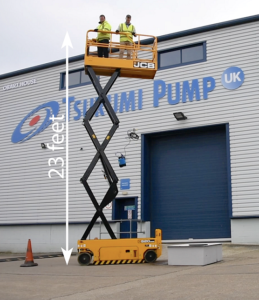Flood Control Project
Construction is advancing ahead final of schedule on the final elements of a $40-million flood control project along the Mississippi River to protect historic Ste. Genevieve, Missouri. Designed to protect the town from an urban design flood, which exceeds a 500-year flood, the project has involved construction of 3-1 /2 miles of levee; two railroad closure structures; a 260,000-gpm combination pump station and gravity drain structure; a 500-acre ponding area; a wetlands mitigation area; and related improvements.
A HISTORY OF FLOODING
Ste. Genevieve has been victimized by high water ever since French fur traders settled there in 1735. Seven floods have occurred at this bend along the Mississippi River since 1973. The town drew worldwide attention in 1993 when tens of thousands of volunteers worked valiantly to build an emergency levee that held back much of the Mississippi's record crest of 49.74 ft at the Chester, Illinois gage. More than 1.1 million sandbags, 40 tractor trailer loads of concrete jersey barriers, and 16,000 truckloads of rock went into the 22-ft high emergency levee that limited flood damage in that area to about $10 million.
"When I walked the levee in 1993, it was frightening," recounts Ralph Beckerman, mayor of the town. "It seemed like a bad dream that lasted almost all summer. It was almost like being in combat."
Flooding throughout the Mississippi River basin that year claimed 47 lives and caused a record $15 billion to $20 billion in damages. The U.S. Army Corps of Engineers rated the disaster a 100-year flood, and, in some areas, a 500-year flood. Just two years later, however, the river rose again, this time reaching within two ft of the 1993 crest. Fortunately, much of the temporary levee was still in place and renewed efforts helped hold back the runaway waters.
A levee at Ste. Genevieve had been discussed after a previous record flood swept the area in 1973, but formal planning for what became known as the Ste. Genevieve Urban Design Levee was not initiated until 1982. The project was authorized in the Water Resource Development Act of 1986. The historic significance of the Ste. Genevieve National Historic Landmark District, spotlighted by the battle against the river in 1993, moved the project ahead in the wake of the great flood.
HOLDING BACK THE WATERS
Value engineering reduced the estimated levee cost from $48 million to $40 million for land acquisition, relocations, design, and construction. In addition to the Urban Design Levee itself, the authorized project includes channel improvements along two tributary streams in town and outdoor recreation facilities. The total project cost estimate stands at $48 million. Federal cost sharing rules have brought the city's share to about $12 million, with $5.5 million derived from the National Trust for Historic Preservation, and another $5 million in a Community Development Block Grant issued by the Missouri Department of Economic Development. The balance of the city's $12-million share will stern from a 0.5-cent sales tax, and the federal government will assume the rest.
The initial construction commenced at the north closure in July 1997 and lasted just over two years. During that timeframe, the relocation of the highway at the south end was completed. Goodwin Brothers and Luhr Brothers crews moved onto the site in summer 1999 and made exceptional progress due to generally dry and mild conditions over the past year.
The levee incorporated one of the largest submersible propeller pump stations in North America at a point 600-œt up from the (South) Gabouri Creek confluence with the Mississippi River and immediately downline from the town's wastewater treatment plant on the land side of the levee. The facility has three, 660-hp axial flow pumps (Model PL 7121 from ITT Flygt, Trumbull, Connecticut) that are individually housed in 12 ft by 16œt by 250-ft concrete box culverts.
The use of submersible propeller pumps follows a design developed in the early 1990s by the Corps of Engineers that integrates the pumps within the levee rather than in a separate, landside structure. Controls for the pumps and sluice gates are housed in a 14-ft by 25-ft electrical building situated atop the structure. Electrical demand peaks are high enough that the pumps will be operated off-peak whenever possible to minimize utility costs. Furthermore, the station will be computer-controlled and fully automated, except for preparations required to begin pumping, such as the closing of the sluice gates.
The pump station structure, gravity drain, inlet, and outlet structures have required 85,000 cu yd of excavation and 7,800 cu yd of concrete. Another 30,000 cu yd were associated with modifying the creek channel, and 130,000 cu yd used to backfill and build the levee stubs. When the Mississippi River reaches a prescribed level, the lattice cast sluice gates will be closed, thereby blocking gravity flow and preventing a backup in the creek from reaching the town, about one-half mile away. The pumps then activate sequentially as the water rises, discharging through 54-in. flap gates. One pump is housed within each of the outlet structure's three contiguous box culverts.
Corps of Engineers specifications required witnessed hydraulic performance tests conducted to Hydraulic Institute Standards. Each pump was also tested for its net/positive suction head requirements, a key requisite for this application, since the pumps must operate over a wide static head range. All performance tests were conducted at the ITT Flygt facility in Sweden. The pumps were subjected to a range of operation from 12 to 28 ft of total head, and capacity varied from 79,000 to 91,000 gpm. After acceptance, the pumps were set within the station in July, and will be field-tested again in late summer.
The $8-million pump station and related facility is on schedule to be completed by late August, well ahead of the due date according to Goodwin Brothers. The station is among the ten largest of the 75 pump stations operated within the St. Louis Corps District.
Luhr Brothers hopes to keep pace and complete the levees by Thanksgiving. By then, they will have moved 1.3 million cu yd of sand and 590,000 cu yd of clay and silt material. The levees are generally 16-ft wide at the crown with 4:1-ft slope to a 216-ft wide base.
“The progress of the levee has been outstanding," Mayor Beckerman noted. "We are going to finish ahead of schedule due to the contractors and Corps of Engineers working together: The quality control that the Corps has taken with the levee has been exceptional. We are going to end up with a First Class Urban Design Levee."
With the town more secure, he envisions an upturn in economic development. A 100-acre business park is planned that will connect the new city with the historic town. That will eventually broaden the employment base, some in the high-tech growth field, the mayor hopes.
"Without the worry of floods, we have the ability to look to the future and to develop some good, high paying jobs for the citizens," he said. "I've already seen investments in properties that didn't take place before as a result of the Urban Design Levee."
Meanwhile, the huge earth moving equipment continues to shape the levee and with it the future of this historic town. The end of the work-and a new beginning-are finally in sight. James Zerega, project manger with the Corps of Engineers, said the remaining contracts will include one for 20 relief wells and another for finish work on the borrow pit that will become the wetlands mitigation area.
Source: Xylem Inc.







